Share the page
Payments for Ecosystem Services. From Theory to Practice - What Are the Prospects for Developing Countries?
Published on

Today, the acronym PES (Payment for Ecosystem Services) has become an omnipresent concept in funding environmental projects, in scientific publications as well as in arenas where environmental and developmental policies are discussed. Companies, political circles, NGOs, donors, researchers – all use it and comment on it. However, the concept only gives the appearance of being a specific and operational notion. On the contrary, it raises several questions: Where has this concept come from and why has it been so successful in discourses? How is this instrument placed in relation to all the environmental tools available? What PES examples have been implemented, what are their strengths and their weaknesses? To what extent could PES systems be applied widely as funding tools for environmental policies? By responding to these questions, this publication offers readers an in-depth reflection on the PES concept and provides them with a fundamental key to better understanding and using this tool.
Useful Information
-
Authors
-
Schéhérazade AOUBID, Tiphaine LEMENAGER, Yann LAURANS
-
Edition
-
7
-
Number of pages
-
218
-
ISSN
-
2105-553X
-
Collection
-
To Know
-
Other languages
